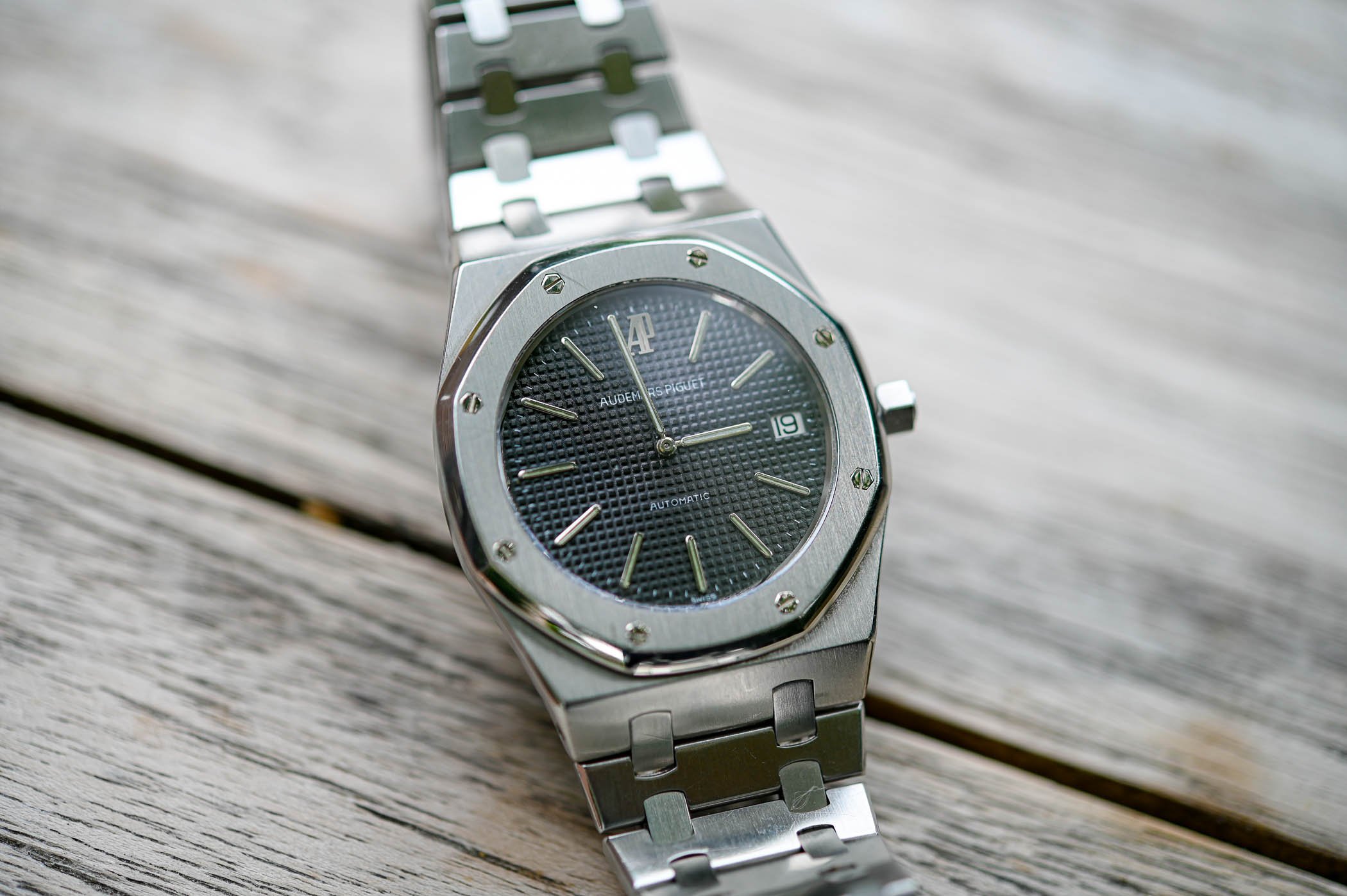
Try our newest merchandise
Is there something new to say concerning the origins of the Audemars Piguet Royal Oak? Because the watch marked its fiftieth Anniversary in 2022, numerous tales, insights, and private accounts surfaced worldwide, deepening our understanding and enriching watchmaking tradition. But to kick off right this moment’s look into the ultra-thin 39mm “Jumbo” editions of this legendary collection, let’s take a second to revisit each the important thing milestones and a few lesser-known info that formed the Royal Oak’s historical past, and we will begin with the nickname.
As all of you realize, the time period “Jumbo” didn’t originate in watchmaking. It dates to Jumbo, the well-known African elephant offered to the Barnum & Bailey circus by the London Zoo in 1882. The nickname later resurfaced in 1969 with the debut of one other big: the Boeing 747. By the mid-Seventies, “Jumbo” started circulating within the watch world to explain the unusually giant Royal Oak, together with different outsized timepieces of the period. By the Nineties, the time period had caught, changing into the universally recognised label for this iconic 39mm model.
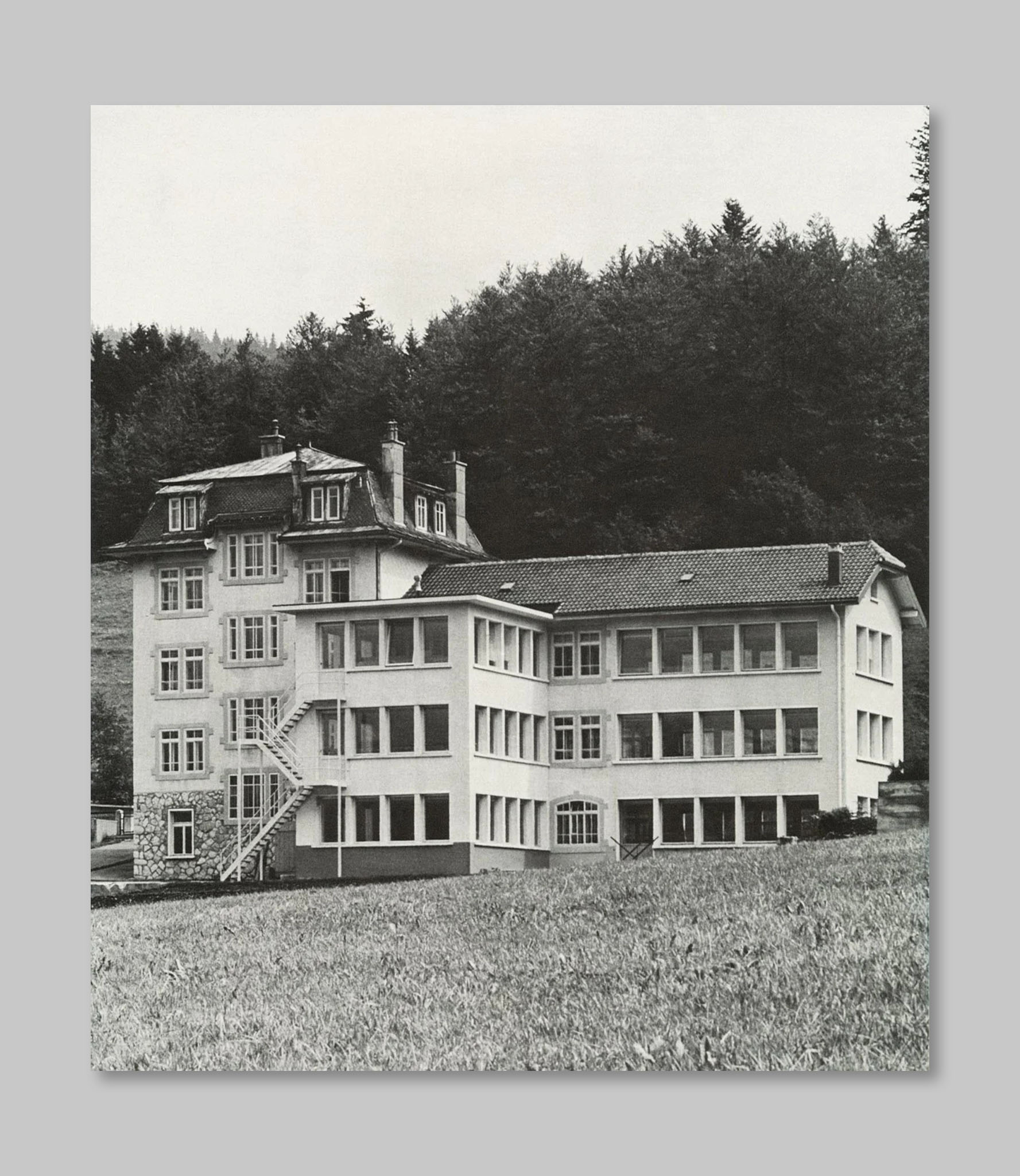
Historic Context
Audemars Piguet created the Royal Oak in 1972 throughout intense socio-economic disruption and transformation throughout the watch trade. The collapse of the Bretton Woods system, with the U.S. ending dollar-to-gold convertibility in 1971, triggered monetary instability that disrupted luxurious markets. On the identical time, the Swiss watch trade was transitioning from a managed, cartel-based construction whereas dealing with a big risk from Japanese quartz know-how: cheaper, extra correct, and radically completely different from conventional mechanical watches.
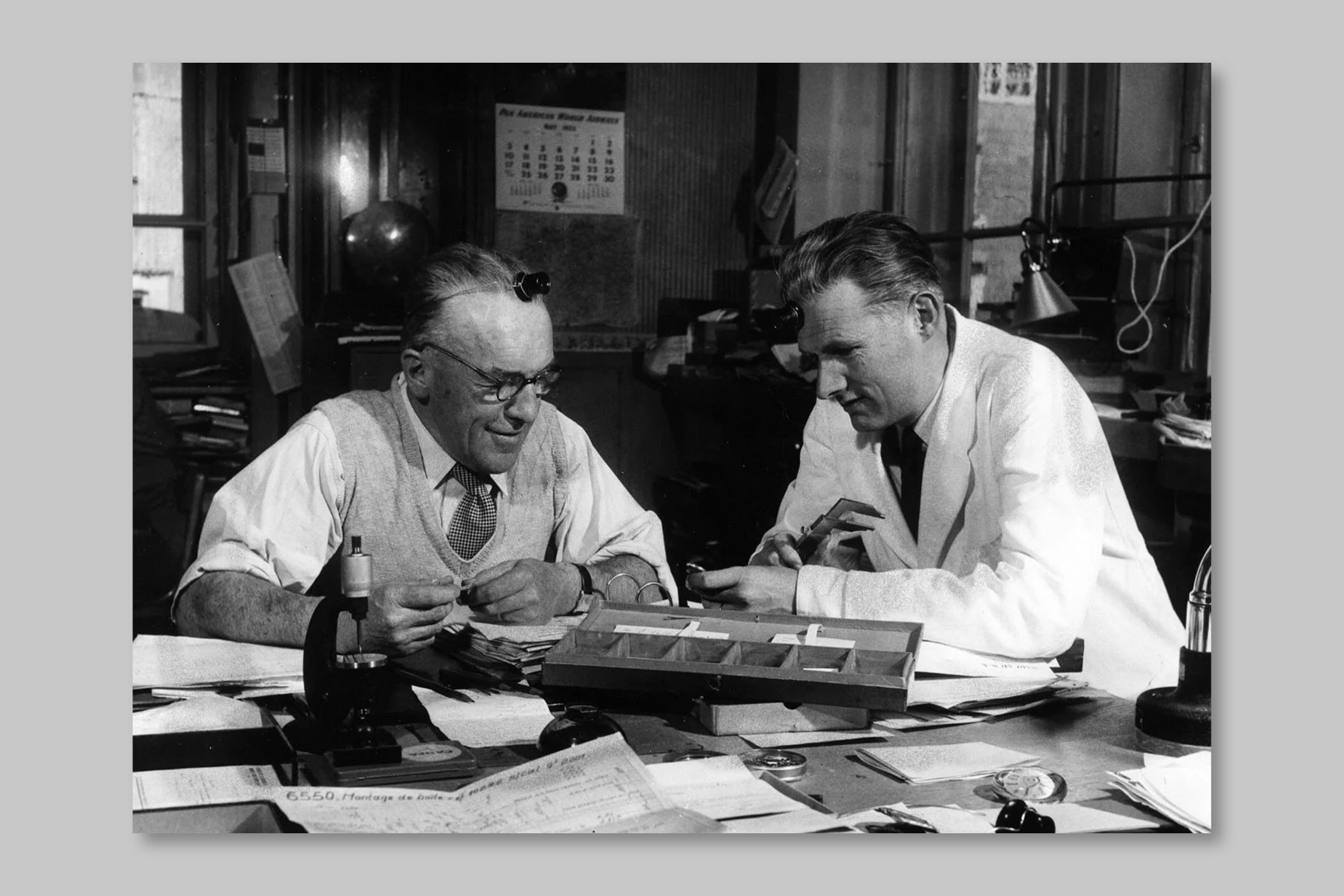



But within the Seventies, Audemars Piguet was a thriving firm nonetheless family-run by Paul Edward Piguet and Jacques-Louis Audemars, and led by Georges Golay, a progressive entrepreneur from the Vallée de Joux who joined AP in 1945 and have become Managing Director in 1967. Submit-WWII, Audemars Piguet deepened its technical capabilities by a key partnership with LeCoultre & Cie, utilizing ultra-thin ébauches just like the Calibre 2120 and 2003. Whereas issues remained central, ultra-thin fashions grew to become a manufacturing focus. As AP scaled, it wanted international attain. In 1969, Golay struck a strategic cope with SSIH (Société suisse pour l’industrie horlogère, a former group of Swiss watchmakers comprising the manufacturers Omega, Tissot and Lemania), granting AP entry to an enormous distribution community (160 brokers and 15,000 retailers) whereas sustaining independence.


This partnership sparked a pivotal second. On April 10, 1970, simply earlier than the Basel Honest, Golay met with SSIH brokers Carlo de Marchi (Italy), Charles Bauty (Switzerland), and Charles Dorot (France), nicknamed the “three musketeers.” They challenged him to create an opulent, fashionable sports activities watch in stainless-steel, refined sufficient for night put on but match for contemporary life. As Golay recalled, they questioned if gold alone nonetheless outlined status, proposing a metal watch that might rival it.
Amid the trade turmoil of the early Seventies, Audemars Piguet confronted a strategic problem. CEO Georges Golay recognised that AP’s give attention to high quality ending, low manufacturing, and sophisticated designs was ill-suited for mass-market or sports activities watches. Metal, seen as too industrial for haute horlogerie, made the concept of a luxurious metal watch appear dangerous, particularly with established metal sports activities fashions by Omega, TAG Heuer, Jaeger-LeCoultre, and Rolex. Pricing such a watch as gold appeared commercially unwise.


Nonetheless, Golay dedicated to the idea put ahead by his brokers, and to design this unprecedented piece, he known as on Gérald Genta, an unbiased designer with a rising popularity. Genta, a educated jeweller, had labored with AP for the reason that Fifties, contributing refined geometric fashions just like the 5179, asymmetrical 5182, and the textured 5199. He additionally designed Common Genève’s Polerouter (1954) and revamped Omega’s Constellation (1959). His artistic synergy with Golay had grown through the years, and by the late Nineteen Sixties, they have been working in near-total sync.


Throughout that afternoon name, after talking with SSIH brokers in 1970, Golay requested Gérald Genta for a metal sports activities watch design that had by no means been achieved earlier than by the subsequent morning. Genta labored in a single day and delivered: an ultra-thin motion in a monocoque case, octagonal bezel with eight hexagonal screws, built-in tapering metal bracelet, and a deep cobalt blue dial with Clous de Paris guilloché and smoky gradient. As Genta later recalled, “The screws, the seal, the bracelet, the dial – it was all there. It was fairly superb.” And so, AP received right down to work.
By April 1971, because the Basel Honest was about to open, Georges Golay launched the white gold prototype to the three musketeers. Carlo de Marchi and Charles Bauty agreed to purchase 400 models every. Georges Golay determined to provide a primary collection of 1,000 in metal, assuming it will be straightforward to distribute the 200 further examples to the remainder of the world.


Not like the Royal Oak Offshore, which began its life with its precise title, by September 1971, Audemars Piguet nonetheless hadn’t settled on what to name its new metal sports activities watch, with choices like Safari, Colorado, Kilimanjaro, Grand Prix, Diane, Surfrider, Canyon, Oxford, Ascot and Yale thought-about. The title “Royal Oak” first appeared within the archives in December 1971, whereas the concept was credited to Italian agent Carlo de Marchi. Impressed by the Royal Navy’s armoured ships and the oak tree that when hid King Charles II from Cromwell’s troops, the title evoked themes of energy, safety, and legend, wealthy with symbolism and open to broad interpretation.
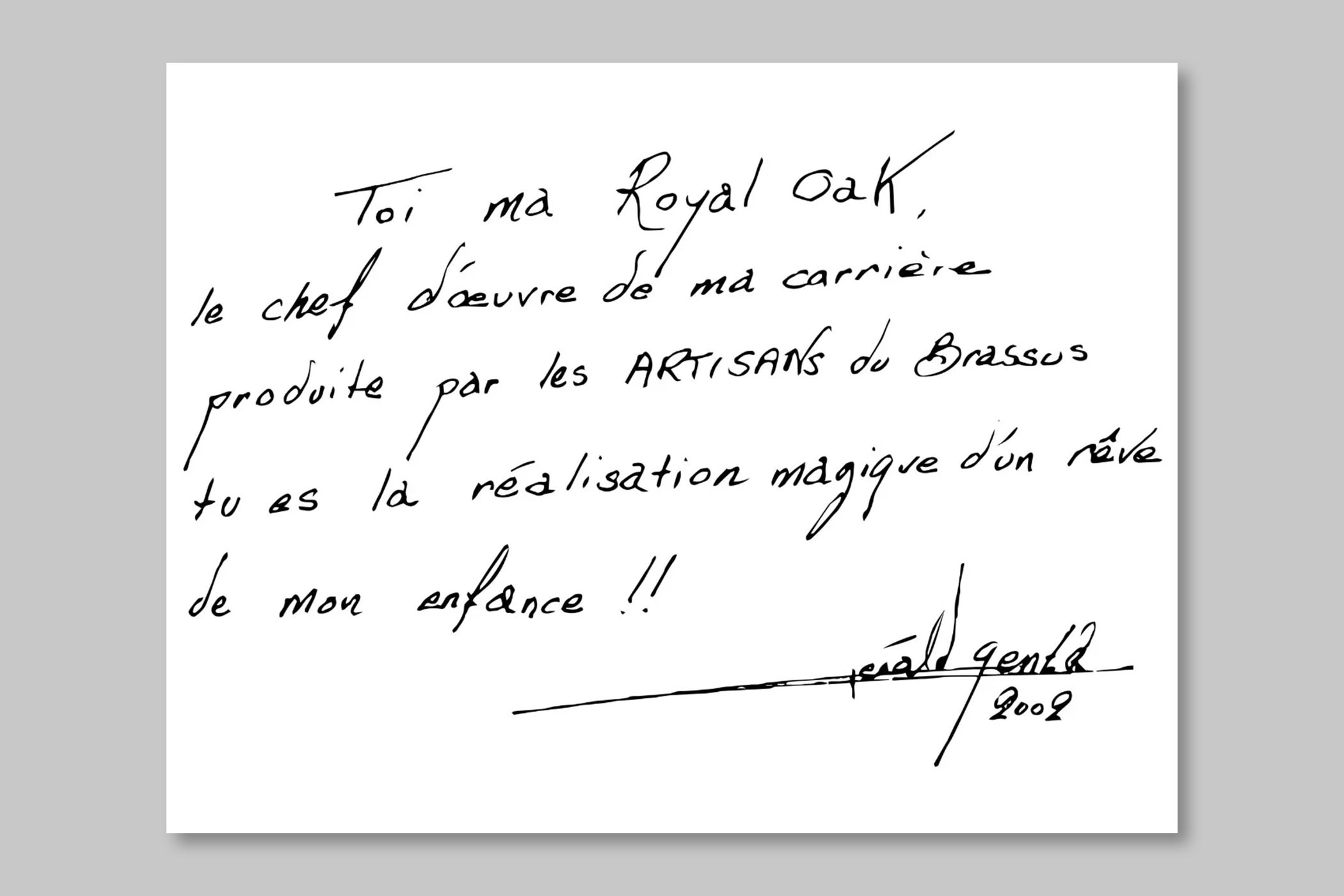

When unveiled in 1972, the Royal Oak would redefine luxurious watch design, defend Audemars Piguet from uncertainties in context, and encourage a wholly new class: the high-end stainless-steel sports activities watch. That very same yr, in Basel, Gérald Genta offered the primary mannequin from his model’s assortment, which he had secretly developed since 1969, ending the designer’s relations with AP.
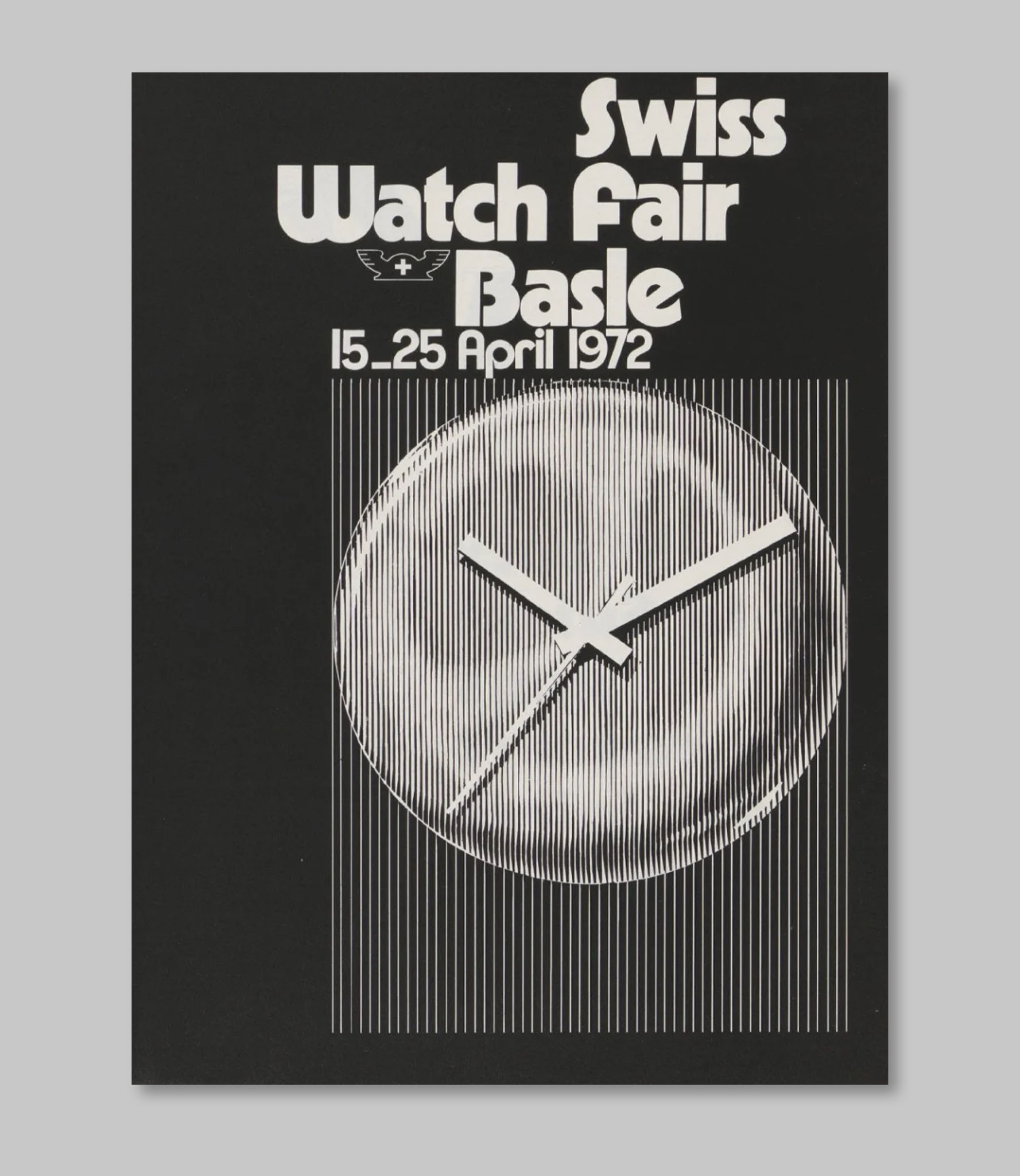

Earlier than presenting the Royal Oak 39mm collection lineage that began with reference 5402ST and developed through the years, enable me just a few phrases concerning the Jumbo’s motion, calibre 2121, which can energy RO Jumbo references till early 2022, for half a century.
The Calibre 2121
Gérald Genta by no means claimed he aimed to design a watch with daring wrist presence: 35-36 mm was commonplace for males’s watches then. Even sports activities fashions have been modestly sized: the Rolex Daytona was 37mm, TAG Heuer’s 1969 Monaco was 38mm, and Jaeger-LeCoultre’s 1970 Memovox Polaris II was thought-about manner too huge at 41mm.


The Royal Oak’s distinctive dimensions have been pushed by its distinctive case building (with the broad bezel design) and the necessity to home an ultra-thin motion (what else!). Eight hexagonal screws pierced the monoblock case and thick gasket, however needed to keep away from the motion. Watchmakers positioned them across the fringe of the calibre 2121, a 28mm broad, 3.05mm skinny selfwinding motion with date, derived from calibre 2120, after which the world’s thinnest.
Launched in 1967 and developed over 4 years in collaboration between Audemars Piguet, LeCoultre & Cie, and Vacheron Constantin, calibre 2120 grew to become one in every of horology’s most celebrated actions. Audemars Piguet used the 2121 model within the first Royal Oak (1972); Patek Philippe within the Nautilus 3700 in 1976 (cal. 28.255c), and Vacheron Constantin in 1977 throughout the 222, utilizing it as calibre 1121. Notably, Jaeger-LeCoultre by no means used the 920/921 motion in its watches.


The primary Audemars Piguet mannequin to function the calibre 2120 was 5271 (1967), designed by Genta and adopted by greater than 10 fashions the identical yr. Calibre 2120 was a mere 2.45mm thick and featured a patented system (CH14338/65) with its rotor supported on the periphery by miniature ruby rollers “to cut back the robust tensions on the central axis bearing the rotor and preserve the efforts concerned in central pivoting to a minimal.” Naturally, the calibre 2121, launched in 1970, retained the modern function and different traits of the 2120: bidirectional winding, 19,800 vibrations/hour, anti-shock system produced by the Kif Parechocs firm, no seconds hand, and decorations of the best commonplace, together with round graining, satin-brushing, polished sinks, chamfering, sharpening, “Côtes de Genève”, gilding, snailing, and the 21-carat gold oscillating weight engraved with the inscription “Audemars-Piguet”, with a curious hyphen between the 2 names. Cal. 2020/2021 continued to evolve till retirement, but to bore you now not, let’s get straight to the Jumbo lineup.


1972 – The Royal Oak jumbo 5402ST, the Blueprint
It may go like this if we have been to short-introduce the primary RO 5402ST in 1972. At Basel this yr, Audemars Piguet unveiled the Royal Oak Ref. 5402ST. It was the primary high-end sports activities watch made completely of stainless-steel, priced on par with conventional gold gown watches. Designed in a single day by Gérald Genta, the 5402ST redefined expectations: it’s mechanically refined, architecturally daring, and unapologetically fashionable.


The case measures 39mm throughout however stays skinny at simply 7.15mm. A monocoque building makes this ultra-slim profile doable, with a one-piece case that eliminates the caseback. The motion is inserted from the entrance, a way usually reserved for specialised, waterproof designs.


The octagonal bezel is secured with eight white gold hexagonal screws, all radially aligned. A visual rubber gasket beneath the bezel provides to the commercial character and contributes to a 100-meter water resistance score, outstanding for an ultra-thin automated timepiece. The dial, produced by Stern Frères, debuts a brand new “Petite Tapisserie” guilloché sample, finely engraved utilizing a pantograph machine. The deep blue hue, Bleu Nuit, Nuage 50, is achieved by galvanic remedy and a contact of black lacquer, making a near-black tone with delicate depth and texture.


White gold hour markers and “bathtub”-style palms are stuffed with tritium for low-light legibility. A date window at 3 o’clock is cleanly built-in, whereas the utilized “AP” monogram at 6 o’clock anchors the composition with an understated stability.


Powering the watch is Audemars Piguet Calibre 2121, Jaeger-LeCoultre Calibre 920/921 base. Measuring 3.05mm thick and 28mm in diameter, it’s among the many thinnest full-rotor automated actions with a date complication. The rotor is ingeniously mounted on a peripheral rail supported by ruby rollers, eliminating the necessity for a central ball-bearing, which reduces thickness and put on. The motion affords a 40-hour energy reserve and makes use of 36 jewels.


The design is accomplished with a completely built-in stainless-steel bracelet crafted by Homosexual Frères. It consists of 154 individually hand-finished elements in 34 completely different sizes. The tapering bracelet flows seamlessly into the case, with no lugs or finish hyperlinks, setting a brand new precedent for case-to-bracelet integration.
Audemars Piguet introduces the Royal Oak Ref. 5402ST as restricted to a 1,000-piece collection at an unprecedented worth of CHF 3,300. That is nothing wanting audacious for a watch made from stainless-steel. By comparability, a Rolex Submariner in metal was round CHF 1,000-1,200, and even many strong gold gown watches from top-tier manufacturers have been priced decrease, usually CHF 2,000-2,500. The Royal Oak’s pricing triggered a stir; prospects and retailers questioned how a metal watch may value greater than a gold one, regardless of how finely completed. However Audemars Piguet was making an announcement: this wasn’t only a sports activities watch; it was a luxurious object crafted with the identical precision, ending, and innovation as a haute horlogerie masterpiece. It was a daring gamble which will change the trade without end.
A, B, C, D – the New Numbering System
As you doubtless know, the 1,000-piece restrict didn’t maintain as Georges Golay selected to not cap manufacturing there but maintained the spirit of a restricted collection by shifting past strict constraints, a choice that brings us to an intriguing shift: how the Royal Oak successfully sidelined Audemars Piguet’s conventional numbering system, which has been used for over a century.
Launching the primary Royal Oak in 1972 raised critical questions on perceived worth. Audemars Piguet deliberate to provide 1,000 items, a scale extraordinary in Le Brassus, the place everybody was used to distinctive fashions or minimal collection. To complicate issues, the watch was made from stainless-steel, a cloth thought-about inferior, but the case was so advanced it value as a lot as gold.
To take care of a way of exclusivity, Golay moved the interior case quantity contained in the case and as an alternative engraved a daring, incremental serial quantity on the caseback, beginning with “No. 1.” This “Royal Oak quantity,” later often known as the “small case quantity,” assured every proprietor that their watch was a part of a restricted collection. And in true strategist trend, Golay prefixed the numbers with the letter “A”, leaving room for future collection B, C, and many others, simply in case the Royal Oak succeeded. As historical past reveals, it did, and the A, B, C and D collection of Mannequin 5402 got here into being.
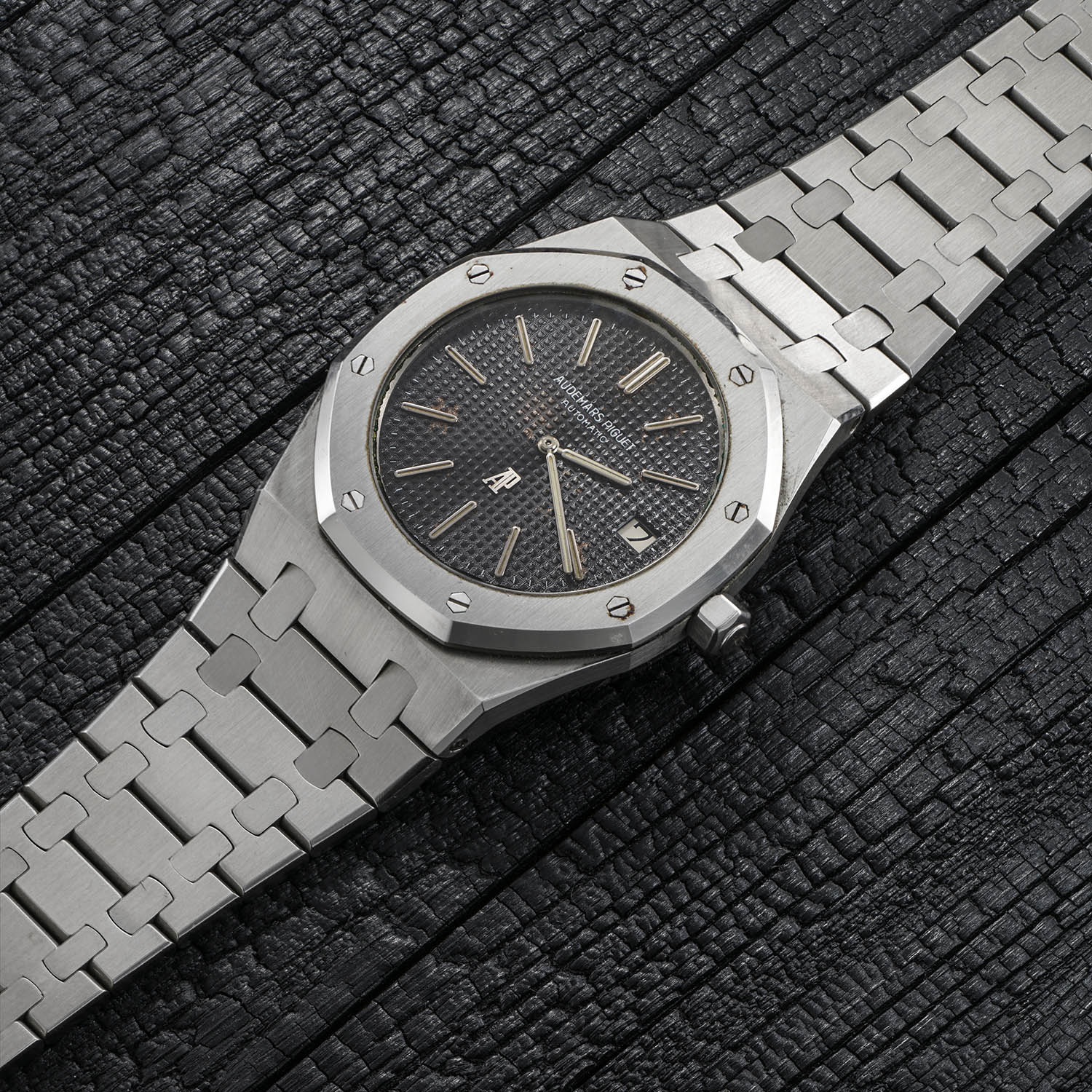

The primary Royal Oak proved an surprising success. By the tip of 1973, over 1,000 models had been offered, prompting Audemars Piguet to increase the A-series manufacturing to 2,000. In whole, 1,937 A-series watches have been offered between 1972 and 1989. On the finish of 1974, as AP reconsidered the mannequin’s future, a small batch of 129 watches was produced and not using a small case quantity, of which practically all have been offered between January and September 1975.
In the meantime, AP launched the B-series, skipping numbers 1–999 and ranging from B1000 to B2000, prone to protect sub-1000 numbers as unique to the A-series. The primary B-series watch left Le Brassus on March 21, 1975, and 845 models have been offered between 1975 and 1993.


The C-series adopted, starting on December 1, 1976, with 953 items numbered from C1000 to C2000, offered by 1987. The D-series got here subsequent, with 404 watches distributed between 1977 and 1989. Lastly, between 1988 and 1990, AP closed the chapter on the unique 5402ST with a uncommon batch of simply 21 items engraved with a “small quantity” however no letter, marking the quiet finish of a legend.
One is correct to ask if the lettered batches had any notable variations. There have been very delicate, like signed or unsigned crowns, refinements in textual content alignment or end, evolution in font and date aperture, variations in Tapisserie texture and minor updates to bracelet ending, principally issues ensuing from updates to manufacturing. Nonetheless, the general design remained purposefully intact to make sure consistency.
The Migration of the AP brand from 6 to 12 o’clock
In fact, there’s the subject of the place of the AP brand, which began at 6 o’clock and moved to the 12 o’clock place someplace on the finish of the Seventies. The model’s archives don’t doc the rationale for this modification, but it surely principally needed to do with the truth that, after a number of years, palms start to rub and even stumble upon the utilized brand to the purpose of stopping the watch (the gap between the hand and the brand is 5 to 10 hundredths of a millimetre). Nonetheless, so as to present a everlasting answer, Audemars Piguet selected February 24, 1977, to maneuver the brand to 12 o’clock, in order to depart ample area for the motion of the hours hand. The subsequent day, an order for brand new dials was despatched to Stern.
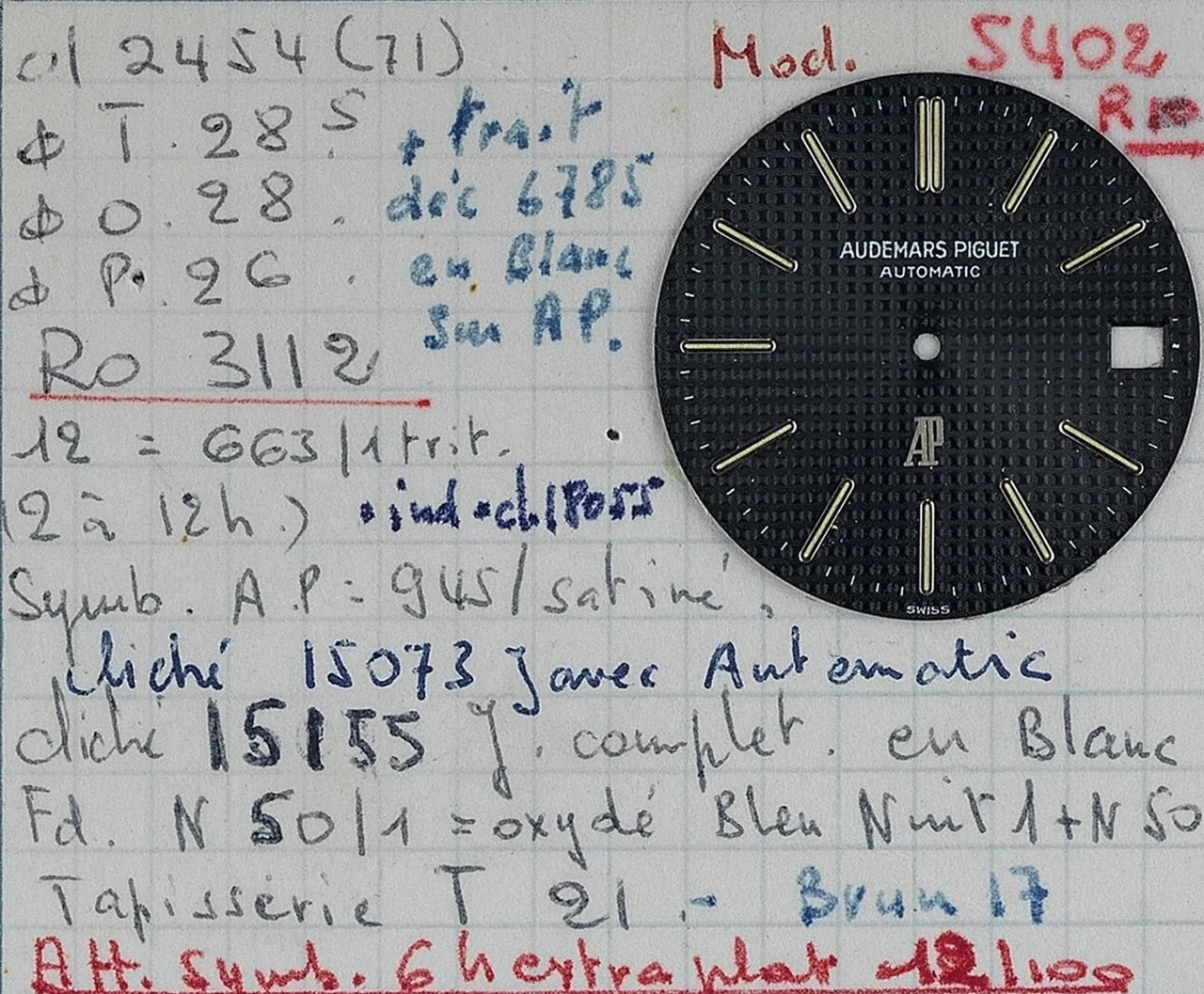

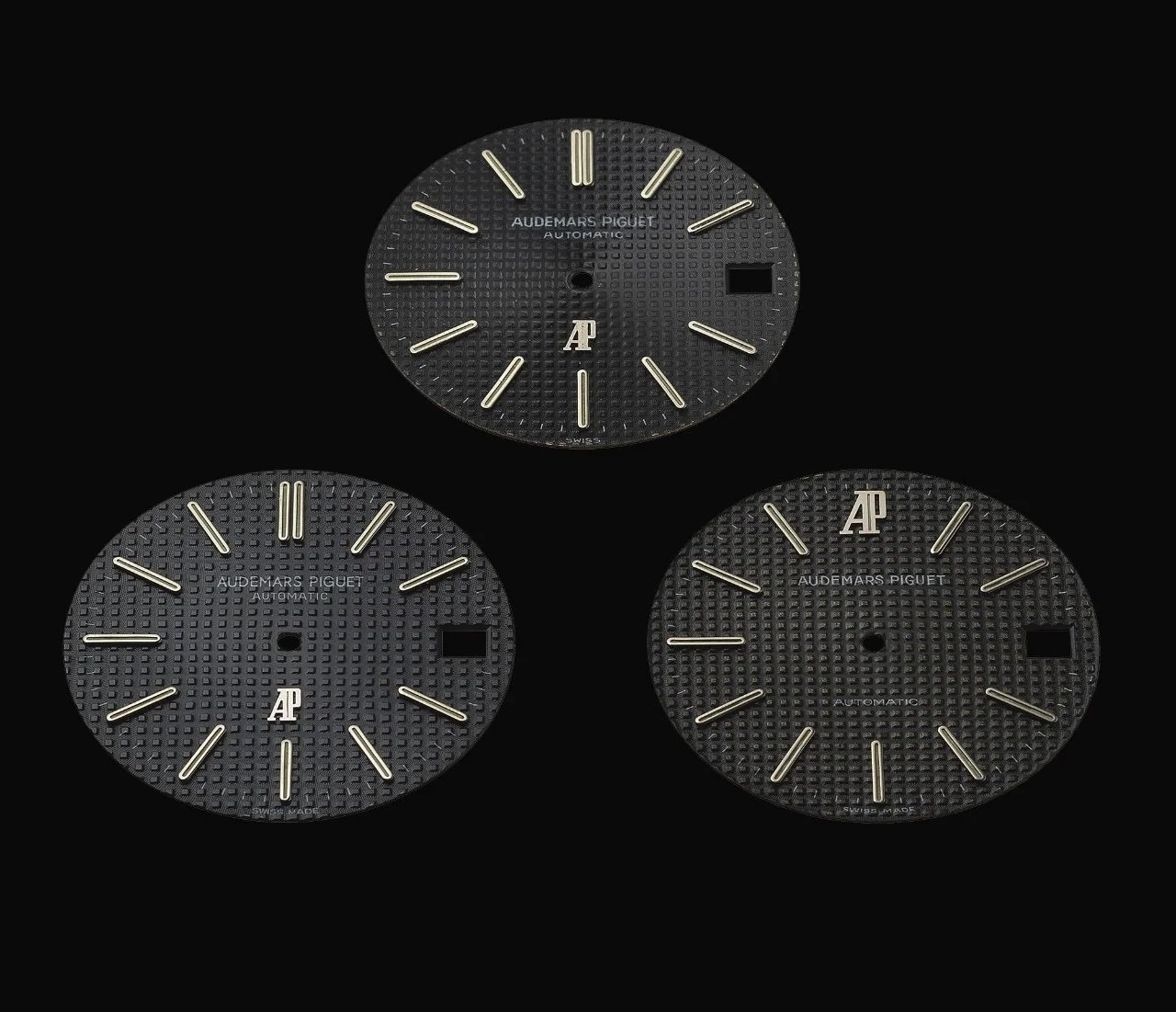

No exact date could be decided to when the final 5402st with AP at 6 o’clock was delivered, or when the primary one with a brand at 12 o’clock was made. Worse nonetheless, AP’s archives don’t even reveal whether or not the 2 variants ever coexisted or not. In keeping with the model, “Allow us to focus completely on the Bleu nuit, Nuage 50 variant with white gold hour-markers, meant for the stainless-steel Royal Oak 5402st. Between 1971 and 1990, the corporate ordered a complete of 4,992 dials, of which not less than 4,085 have an AP monogram at 6 o’clock – implying {that a} most of 907 had it within the 12 o’clock place. In an amusing little train, assuming that every of the final 907 Royal Oak watches offered have been geared up with a dial bearing a brand at 12 o’clock, the dial change would have taken place within the spring of 1978, i.e. round quantity 1500 of the C collection.”


Persevering with this logic, Audemars Piguet provides that if it “had used the 4,085 dials with the AP monogram at 6 o’clock obtainable in inventory earlier than beginning to use the dials with AP at 12 o’clock, the watchmakers would have began to equip 5402 watches with AP at 12 o’clock dials in November 1981, comparable to the tip of the D collection. Solely 219 new watches would have been fitted with this dial on the time of their first sale. This speculation is much more inconceivable as a result of it implies that Audemars Piguet would have waited greater than three years between the order of the primary “6 o’clock” dials and their first use! The reality in all probability lies someplace between these two extremes, between February 1977 and November 1981.”
Royal Oak Jumbo meets Gold – Ref. 5402BA, 5402SA, 5402BC
Whereas metal stays the hallmark of the Royal Oak, treasured metals started coming into the 5402 line in 1977, with one notable exception: a singular white gold piece delivered to the Shah of Iran in 1972.


The 5402BA, crafted in yellow gold, marks the primary official treasured metallic model. Produced in 736 models (numbered 1–745) between 1977 and 1990, it seems in a number of dial variations – some gem-set, some that includes a white date disc, although most use an identical gilded disc. A extra inflexible white gold clasp quickly changed early yellow gold folding clasps.
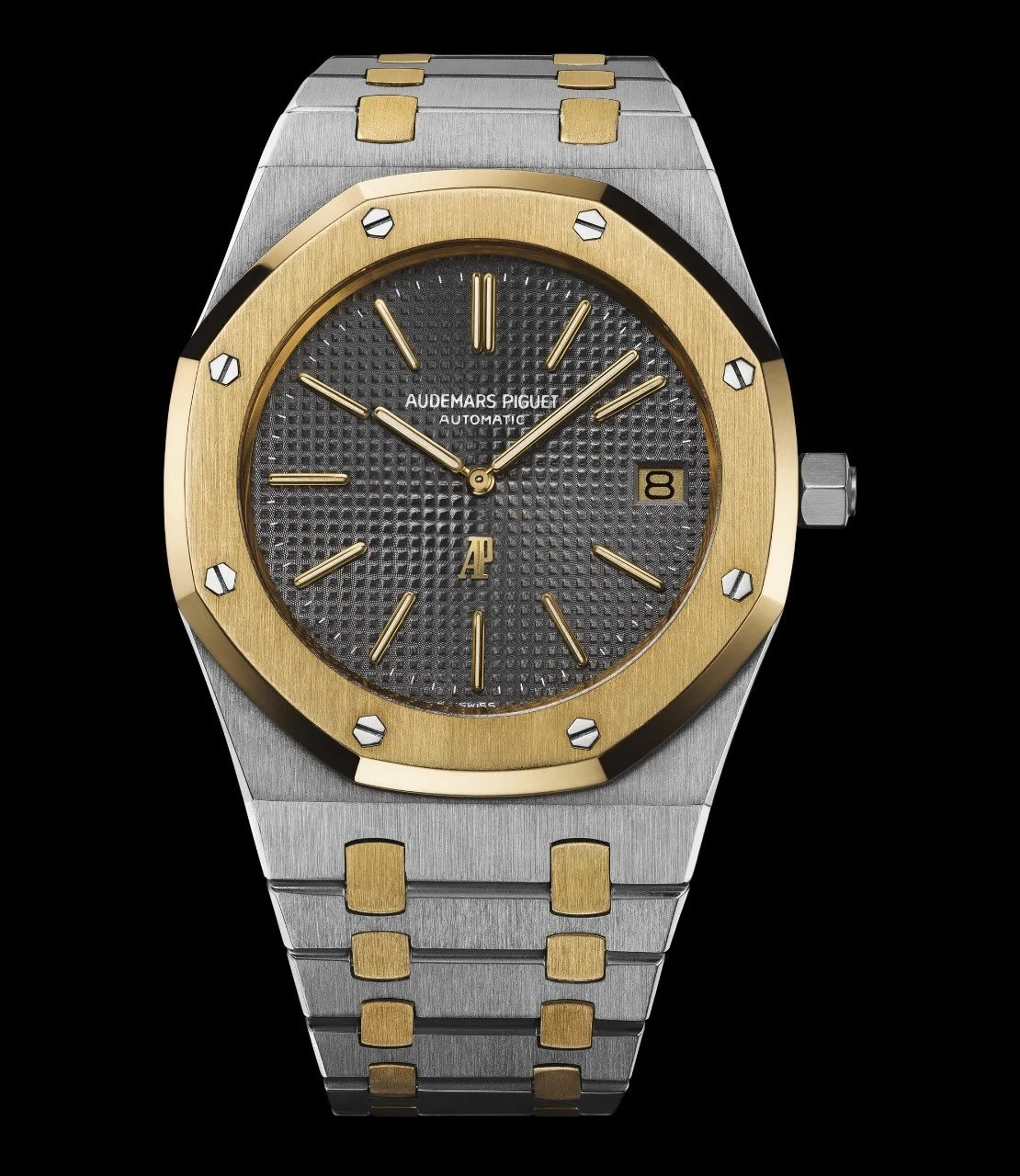

Additionally launched in 1977 is the 5402SA, the two-tone variant combining metal and yellow gold. It incorporates a slate gray dial with matching yellow-gold palms and hour markers, providing a placing play of distinction and reflection. From 1978 to 1985, 876 examples have been offered, numbered 1–951.


That very same yr, AP debuts the 5402BC in white gold. Sometimes set with 11 diamond hour markers mounted on spherical or sq. white gold bases, it additionally affords a spread of dial colors. Not like its siblings, it comes with non-tritium baton palms. A uncommon version, simply 150 items have been offered from 1977 to 1991, numbered 1–151. These treasured metallic variants broaden the Royal Oak’s attain, reinforcing its identification as a sport-luxury pioneer and a real platform for elegant variation.
1992 – The Return of the Royal Oak Jumbo, the Reference 14802
For its first 20 years, the Royal Oak (excluding perpetual calendars) existed in only one measurement: the unique 39mm “Jumbo”, practically all offered earlier than 1982, with just a few quiet years after as there have been different Royal Oaks to contemplate on provide (the gathering comprised virtually 20 references – 150 fashions in metal, gold, platinum, in rectangular circumstances, with practically 30 completely different calibres).


The 1992 commemorative Royal Oak Jubilee Ref. 14802 was issued as a 1,000-piece restricted version, paying tribute to the unique Ref. 5402. Manufacturing included 692 in metal with blue and salmon pink dials, 286 in yellow gold (14802BA, ivory and slate gray dials, gold and white dials added later), and 20 in platinum (14802PT, blue and hammered Tuscany blue dials, launched from 1995 onward).




Picture by Phillips Watches
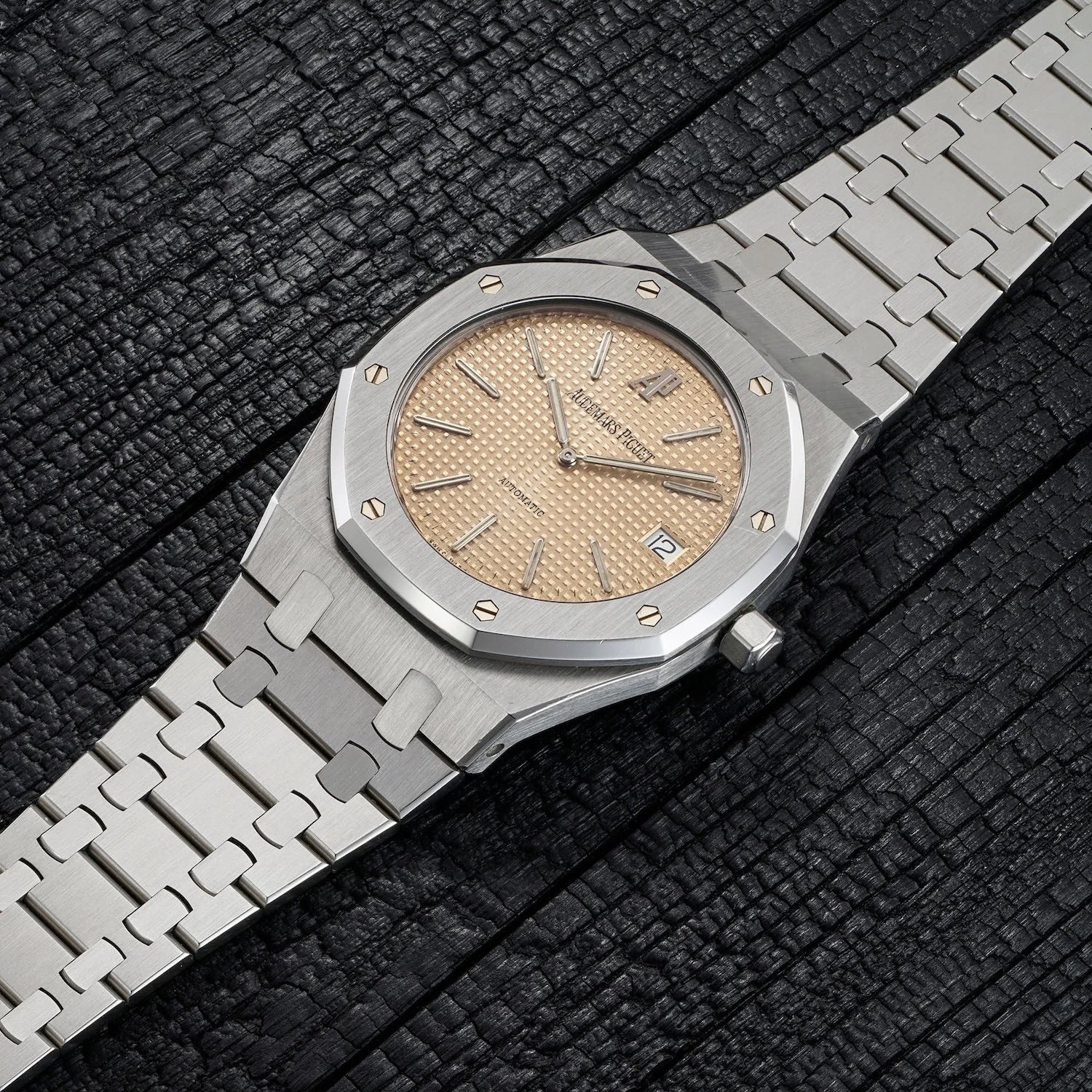

Picture by Phillips Watches


To showcase the motion, a three-part case changed the monobloc one, so the sapphire caseback supplied a transparent view of the Calibre 2121, with most gold rotors engraved with a Twentieth-anniversary motif and corresponding case quantity. One other notable distinction is repositioning the AP brand to switch the 12 o’clock index.
1992 – The Royal Oak Jumbo Openworked Calibre 2020
Between 1992 and 2000, Audemars Piguet launched a number of ultra-thin “Jumbo” Royal Oak fashions in very restricted numbers. Most have been openworked, gem-set, and powered by the Calibre 2120 with no date show.


The primary was the distinctive Royal Oak 14811 (1992), created to assist the newly based Audemars Piguet Basis. It featured a finely engraved oak tree, a motif later seen on fashions 15075, 12517, and 12530. Different notable items embody the gem set, openworked 14789, 14793, and 14814, whereas fashions 14884 and 12518 (a one-off for the model’s one hundred and twenty fifth Anniversary) showcased a naval anchor and stormy waves, nodding to the gathering title’s doable maritime hyperlink.
1996 – The Discreet One, Royal Oak Jumbo reference 15002
As early as 1991, Audemars Piguet had plans to reintroduce a non-limited Royal Oak Jumbo that includes a strong caseback. Nonetheless, manufacturing was postponed till all 1,000 models of the Jubilee reference 14802 had been offered, which in the end took 4 years. By 1996, with 350 Calibre 2121 ébauches obtainable, the stage was set for a brand new launch, and AP unveiled reference 15002. Nonetheless, manufacturing remained extraordinarily restricted: over the subsequent three years, simply 174 items have been made in metal and 12 in yellow gold.


The 15002 stayed true to the unique 5402’s design, preserving the monocoque case, Tapisserie dial, tapered bracelet, and outsized gasket. The bezel’s bevel angle was probably the most vital change, which elevated from 40 to 45 levels. Extra tweaks included a barely bigger AP monogram at 12 o’clock and an enlarged Audemars Piguet signature. Regardless of its constancy to the 1972 authentic, the 15002 underscored the necessity for a modernised model that might carry the “Jumbo” into the twenty first century.
2000 – The Fashionable Royal Oak Jumbo reference 15202 (first era)
By 1999, with the discontinuation of reference 15002, Audemars Piguet was able to usher in a brand new period for the Royal Oak “Jumbo.” The model had formidable plans: 250 items in stainless-steel and 50 in gold, all to be produced in 2000. The outcome was the debut of the 39mm Royal Oak Ref. 15202, unveiled at SIHH that very same yr.
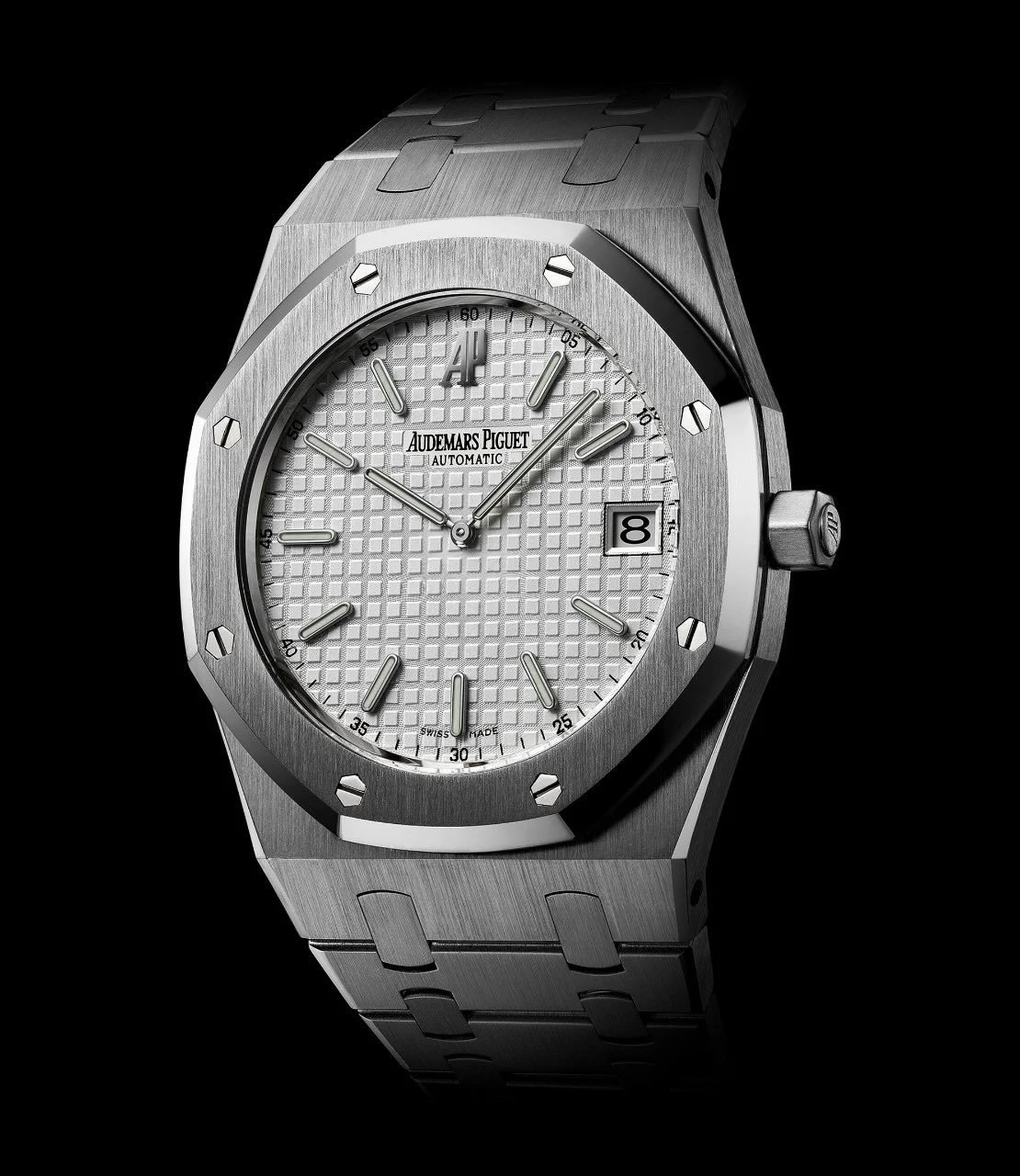

The brand new 15202 launched a contemporary tackle the basic, providing two blue dial variants and a silver-toned model, additionally obtainable in yellow gold (Ref. 15202BA). In 2006, a rose gold 15202OR with a silver dial joined the lineup. These fashions stood out for his or her Grande Tapisserie dials, a departure from the standard Petite Tapisserie, including a bolder texture to the enduring face. The case additionally returned to a three-piece building with a sapphire crystal caseback, although this replace got here with a trade-off: water resistance dropped by 50 meters. Nonetheless, the watch retained its authentic proportions, staying true to the Jumbo DNA.
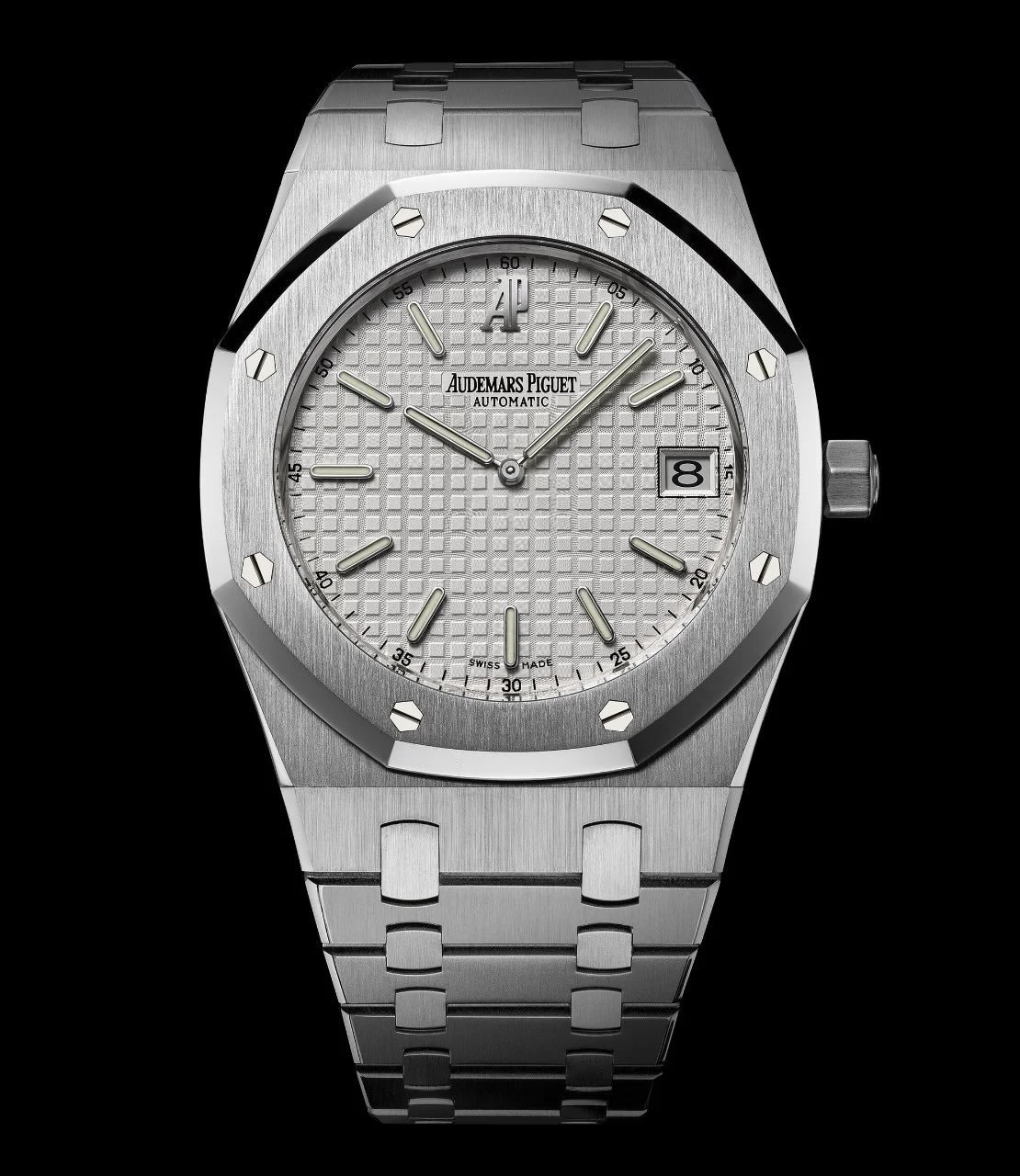

The early 2000s additionally introduced some standout restricted editions. The Jumbo Ref. 15128ST, explicitly created for the Italian market, featured a blue dial with Arabic numerals, a singular design alternative throughout the Jumbo collection, and got here with a further inexperienced dial, additionally marked with Arabic indices. The rotor was specifically engraved with “Anniversaire Royal Oak Italie,” highlighting exclusivity.


And a serious shift occurred behind the scenes. Round 2002, AP started in-house manufacturing of Calibre 2121, ending a long-standing reliance on exterior suppliers. This transfer in direction of motion independence adopted the conclusion of its strategic partnership and partial possession of Jaeger-LeCoultre, through which AP held a 40% stake from 1986 till 2000.
2012 – The fortieth Anniversary and the Second Era Reference 15202
For the reason that Royal Oak’s fortieth Anniversary, reference 15202 took flight in a manner that reshaped the fashionable legacy of Audemars Piguet. Revived with dials that paid tribute to the unique 1972 Sequence A fashions, that includes the AP brand at 6 o’clock, the basic Petite Tapisserie motif, and the enduring Bleu Nuit, Nuage 50 hue, the 15202 appeared in each stainless-steel and rose gold. Alongside them got here standout variations just like the yellow gold model with placing blue and gold-toned dials and the up to date openworked 15203 in platinum with blackened bridges, adopted by a sublime pink gold version.




By the mid-2010s, the 15202 was the one 39mm mannequin within the Royal Oak assortment. As demand for the “Jumbo” continued to develop, 2018 noticed the revival of bi-colour editions. The Royal Oak 15202IP paired titanium and platinum, showcasing a smoked blue gradient dial. The white gold 15202BC emerged a yr later, that includes a heat pink gold-tone (salmon) dial. In 2021, platinum returned with the 15202PT, this time with a easy smoked inexperienced sunburst dial: fashionable, minimal, and opulent.


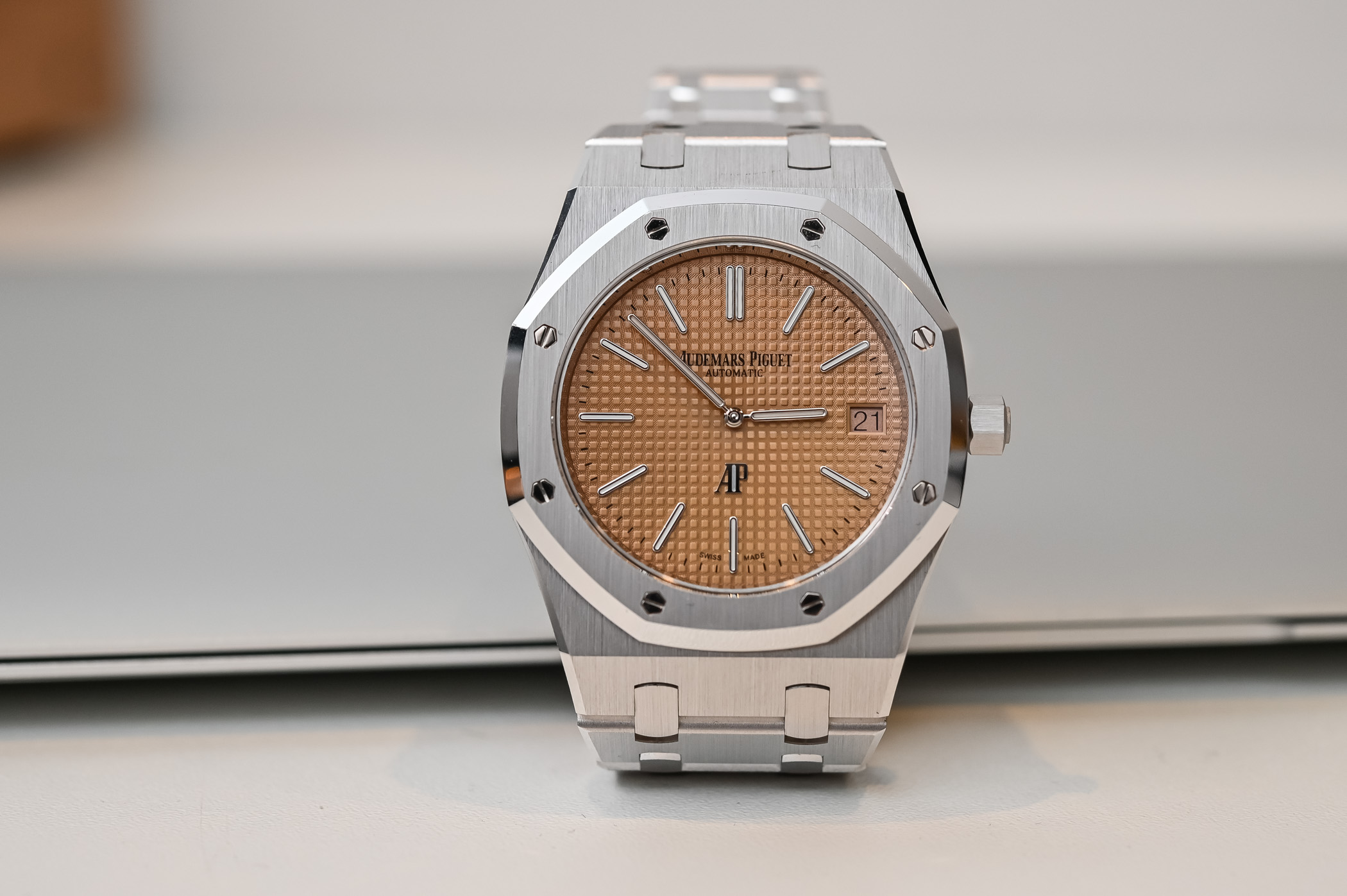

Then got here the finale. Audemars Piguet introduced the tip of the 15202 line, closing the chapter with a one-of-a-kind piece: the Royal Oak 15202XT Jumbo for Solely Watch 2021. Crafted in bead-blasted titanium with a metallic glass bezel (a palladium-based alloy), it was a becoming sendoff to a reference that had outlined a decade of contemporary Royal Oak historical past.
2022 – The fiftieth Anniversary and the Royal Oak Jumbo 16202
To have fun the fiftieth Anniversary of Royal Oak, Audemars Piguet introduced seven new calibres into the gathering, and all 72 references in manufacturing have been fitted with a “50 years” anniversary rotor. A brand new Royal Oak “Jumbo” reference was revealed, the 16202.


The Royal Oak Ref. 16202 is remarkably true to the aesthetic codes of the unique 5402, faithfully preserving design, whereas probably the most vital evolution was the introduction of the newly developed Calibre 7121 to the collection. Barely bigger in diameter (29.6 mm vs. 28 mm), the motion retained a slim 3.2 mm profile and introduced fashionable technical enhancements, just like the added quick-set date operate.
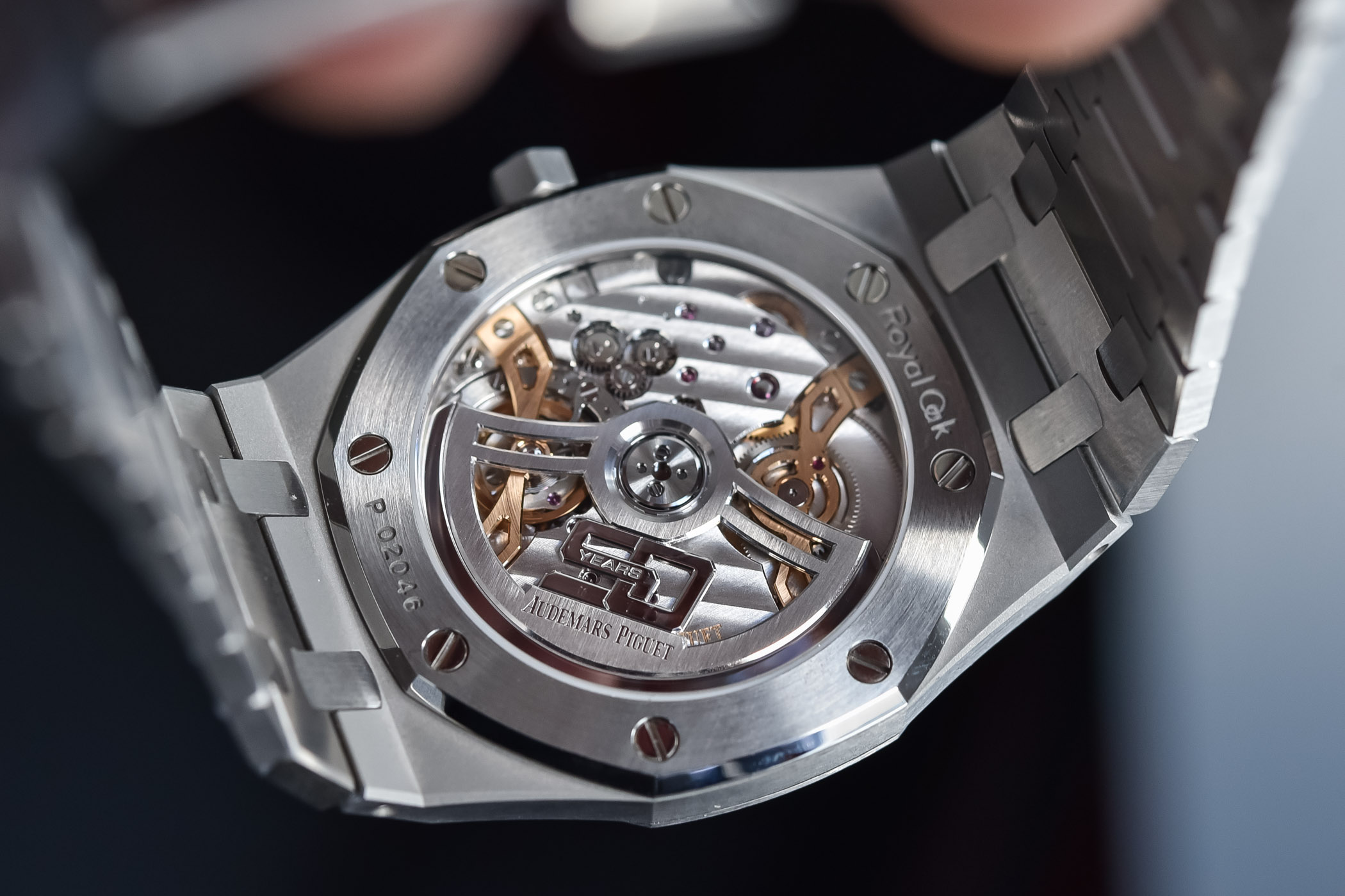

The brand new going prepare format freed up central area to accommodate a wider rotor hub, eliminating the necessity for the 2121’s assist ring and enabling a bigger barrel. The outcome was a better torque output and an elevated energy reserve of 55 hours. The barrel is notably giant and thick-walled, even permitting it to be mounted with screws. Whereas this reduces area for the mainspring, the spring shops considerably extra power, making the strong barrel an efficient torque capsule. Visually, the motion stands out with a skeletonised rose gold barrel bridge that doubles as structural assist. The ratchet wheel is purposefully small, sitting flush with different wheels to keep up thinness.
The stability meeting makes use of a free-sprung, wide-rimmed stability with six adjustable weights and an unusually offset stud holder mounted on a separate bridge for stability and simpler servicing. This design preserves the rigidity and flatness of the lengthy stability bridge and helps regulate beat error for improved timekeeping. Working at 28,800 vibrations/hour, the motion delivers higher chronometric stability, and the bi-directional automated winding system was additionally upgraded. If the motion contained in the Royal Oak Ref. 16202 marked a technical leap, the outside remained virtually completely devoted to its predecessor. The dial, markers, and palms have been nearly unchanged, preserving the attraction of the unique design.


The long-lasting dial of the metal reference 16202ST retained its signature shade of Bleu Nuit, Nuage 50, a color deeply tied to the Royal Oak’s identification, however now achieved by PVD. Key parts just like the hour markers, minute monitor (minuterie), utilized AP brand, the “Audemars Piguet Automated” textual content, and the date window all stay in place, visually untouched (virtually as there have been updates, just like the date window that has been shifted ever so barely nearer to the sting of the dial, a delicate adjustment necessitated by the brand new motion).
Regardless of the mechanical improve, the case dimensions stay an identical: 39mm in diameter and eight.1mm thick. The bracelet additionally stays true to type but comes with higher ergonomics, with its signature hand-finished satin brushing and polished chamfers, and is secured by the identical double folding clasp used on the 15202ST. From the skin, the 16202ST was practically indistinguishable from its predecessor.
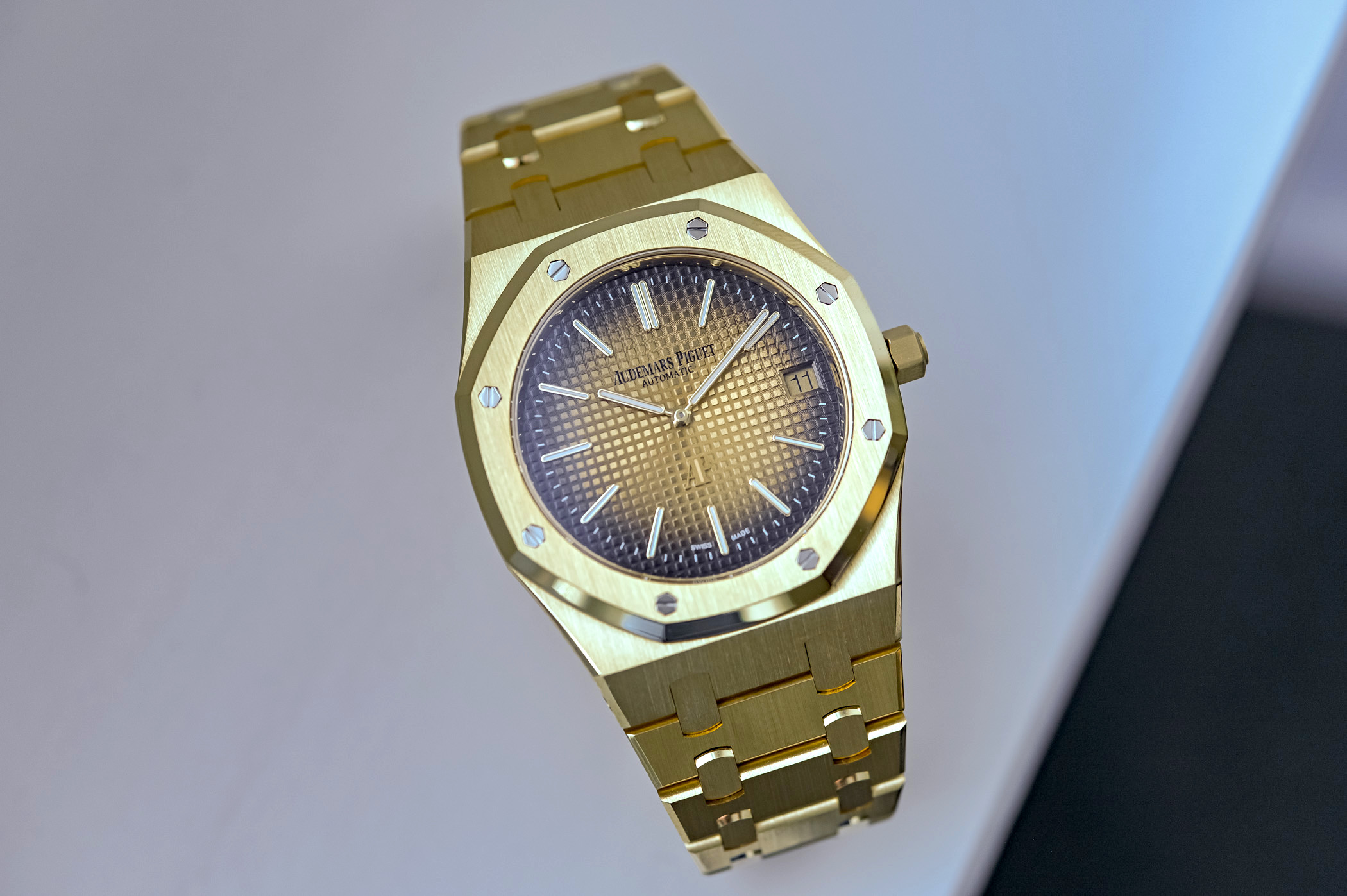

Together with the metal reference, the 16202OR in pink gold with a smoked Petite Tapisserie dial in gray and 16202BA yellow gold with a yellow gold-toned dial have been launched, whereas the platinum 16202PT got here with a deep smoked inexperienced sunburst dial, evoking the color of the spruce bushes within the Vallée de Joux. In 2023, the 16202BC, a boutique-exclusive white gold model with a grained blue Tuscan dial, was revealed, and the 16202XT in light-weight titanium and BMG, an modern palladium-based alloy, with a placing burgundy dial.


As well as, openworked variations in metal and gold (16204ST in 2022, 16204BA in 2023, 16204BC in 2024) have been launched, with a wholly new skeletonised mechanism measuring a mere 2.7 mm in thickness, Calibre 7124, with no date indication.
2022 – The primary Tourbillon in a Royal Oak Jumbo, The RD#3 reference 26670ST
Because it grew to become customary to incorporate all 39mm ultra-thin RO fashions into the Jumbo class, let’s conclude the story by mentioning the Royal Oak Selfwinding Flying Tourbillon Further-Skinny RD#3, the primary “Jumbo” in fifty years to flaunt an automated flying tourbillon (Ref. 26670ST). 5 years in improvement, Audemars Piguet’s ultra-thin automated flying tourbillon marked a big technical achievement, launched as a part of its Analysis and Improvement (RD) collection.
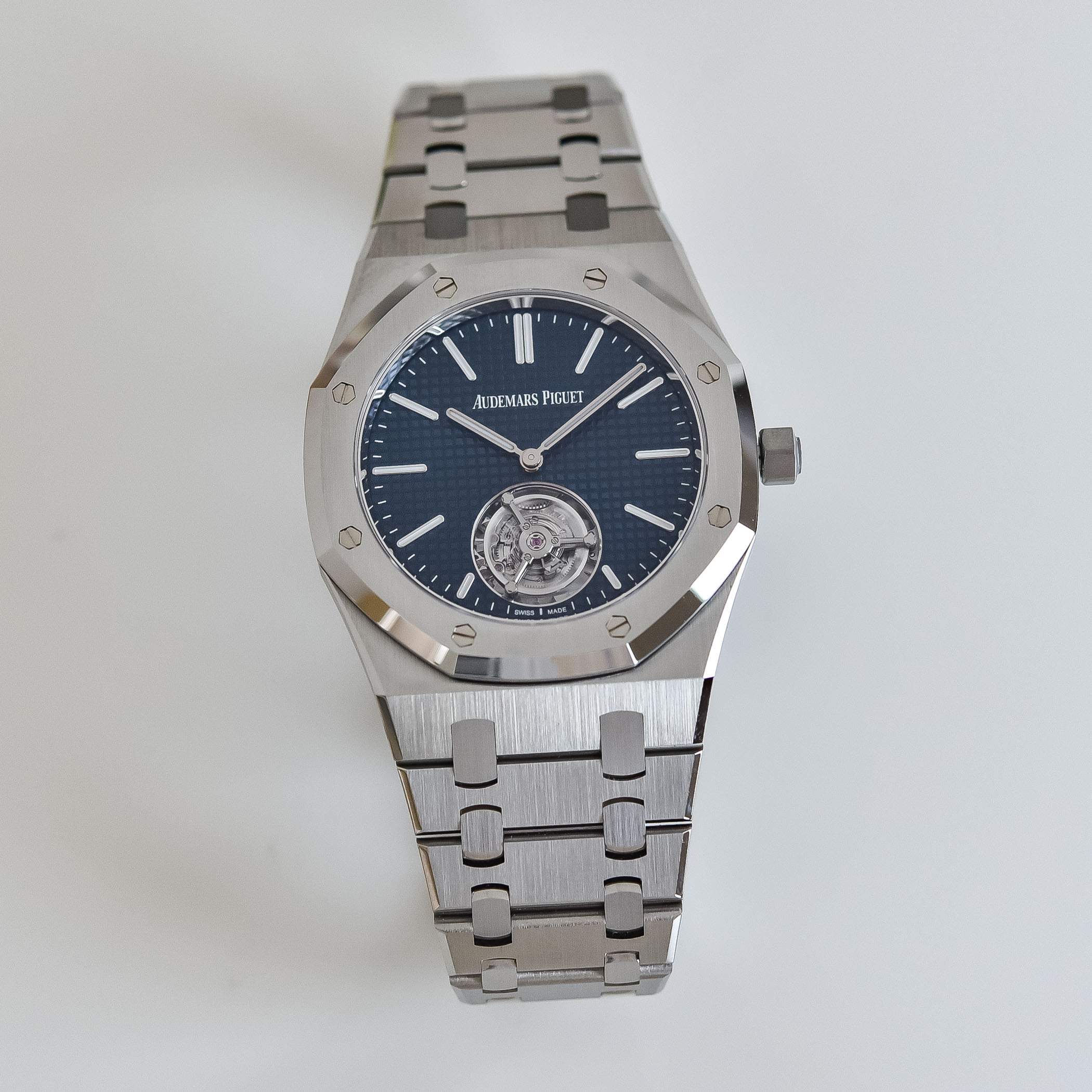

In 2022, AP launched the RD#3, powered by the newly developed Calibre 2968, to have fun the Royal Oak’s fiftieth Anniversary. Not like its predecessors, RD#3 was not an idea however a manufacturing mannequin, first launched in a 39mm “Jumbo” case, with a 37mm model arriving later within the yr with a unique dial color.
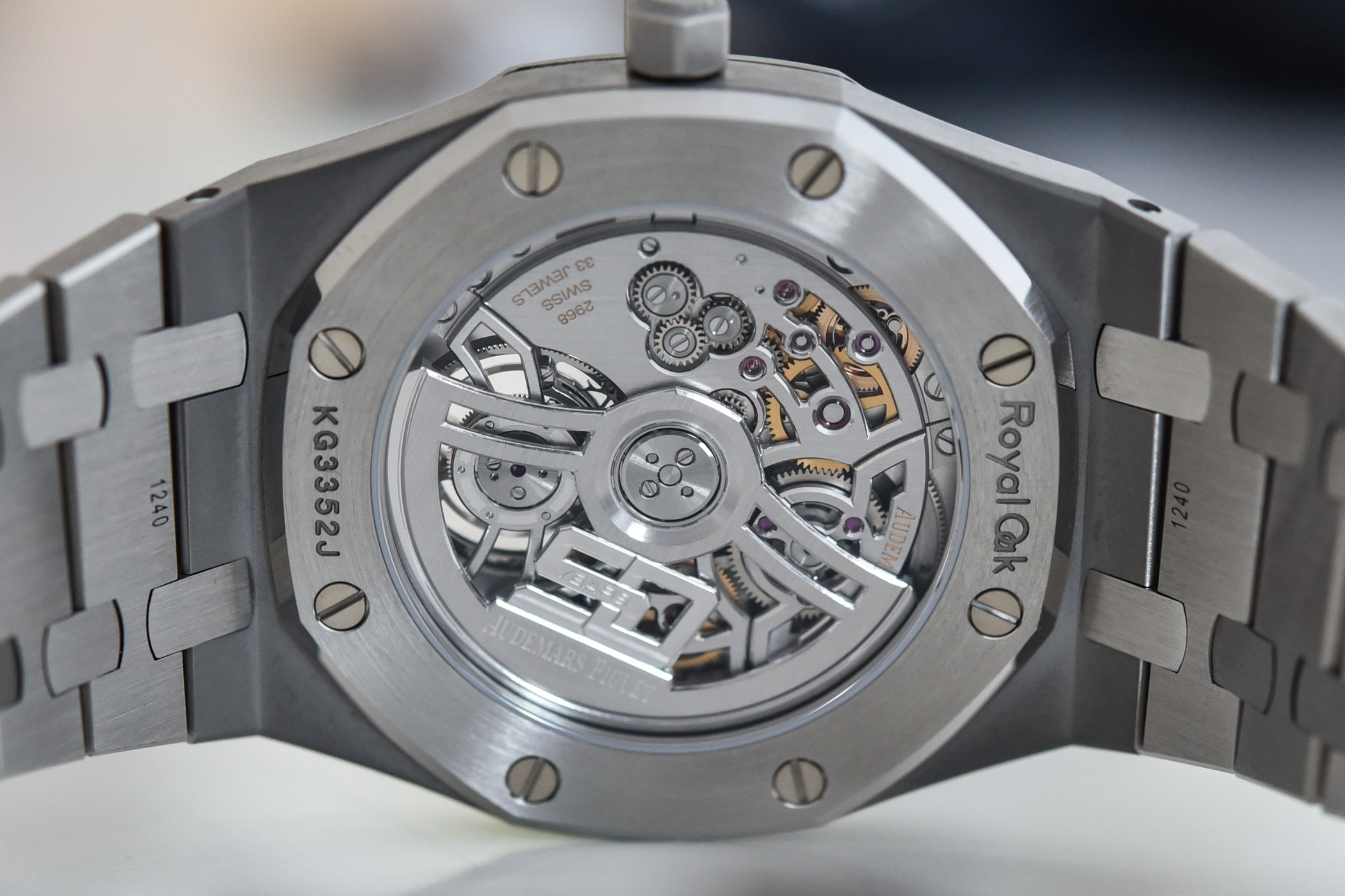

Adapting a flying tourbillon, beforehand restricted to 41mm circumstances, into the slimmer 39mm Jumbo required a complete reengineering. The titanium tourbillon cage was redesigned with a peripheral drive, decreasing mass and enhancing power distribution. For visible affect, the tourbillon was positioned at dial stage, and the stability arms have been repositioned to disclose extra of the motion in motion, providing technical finesse and a placing view of the watch’s mechanical heartbeat.
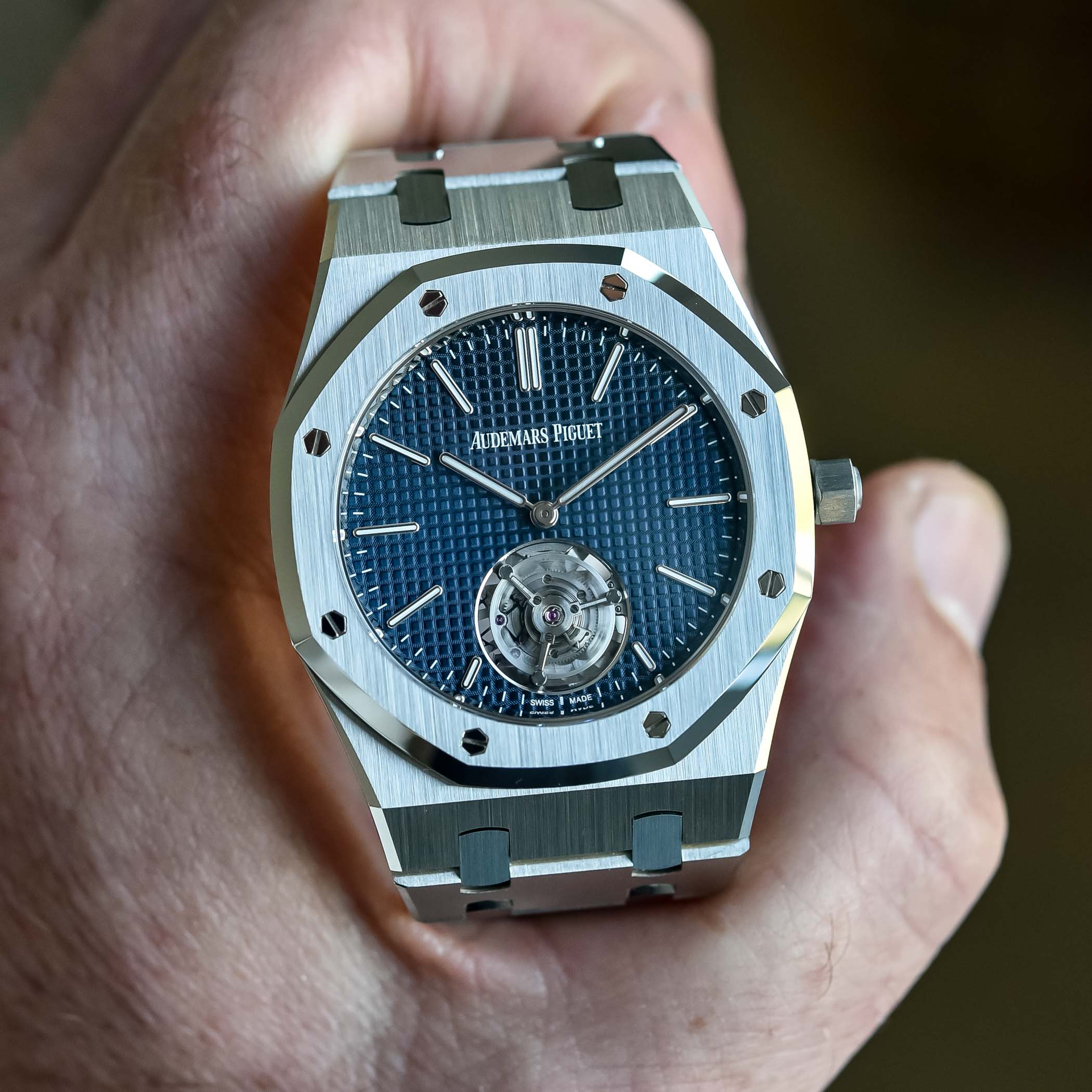

Over 5 many years, the Royal Oak Jumbo 39mm has developed from a disruptive design idea into one of the vital revered timepieces in fashionable watchmaking. From the unique Ref. 5402 that redefined luxurious in metal, to the technically refined 16202, the Jumbo has persistently balanced custom with innovation. Every era has paid homage to Gérald Genta’s authentic imaginative and prescient. As Audemars Piguet continues to broaden the Royal Oak lineage, the Jumbo 39mm stays the cornerstone of the gathering: distinctive in design, exact in execution, and all the time on time.
https://monochrome-watches.com/complete-history-of-the-audemars-piguet-royal-oak-jumbo-series-5402-14802-15002-15202-16202-review/

3 Pack Screen Protector Film, compatible with Rado R12.413.803 TPU Guard for Smart watch Smartwatch ( Not Tempered Glass Protectors )











